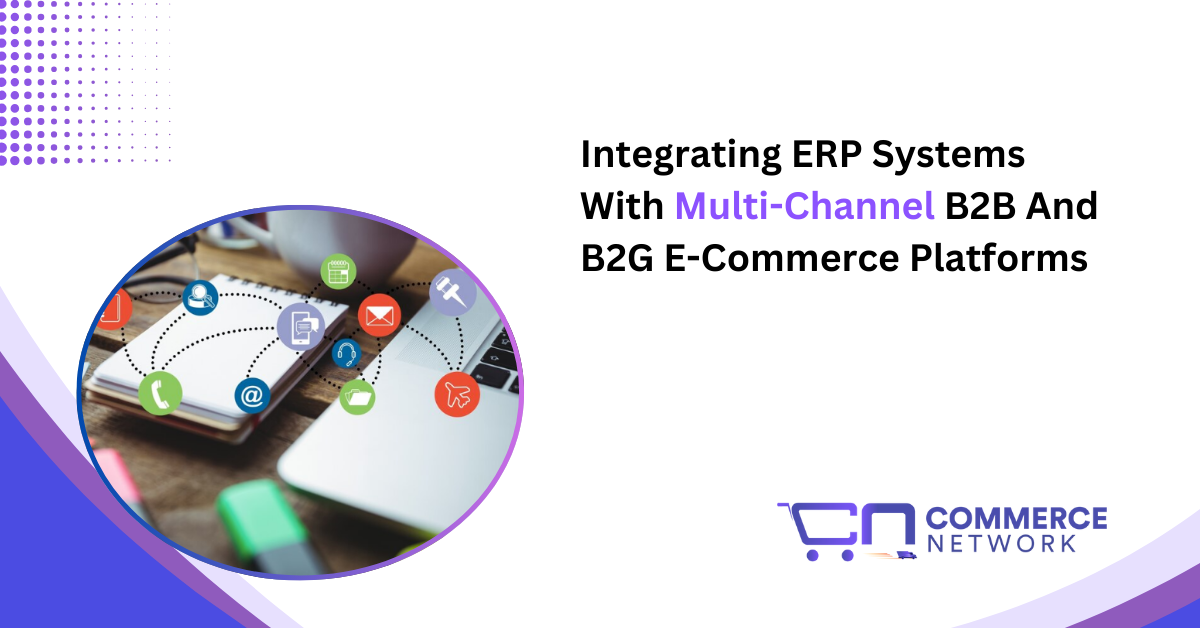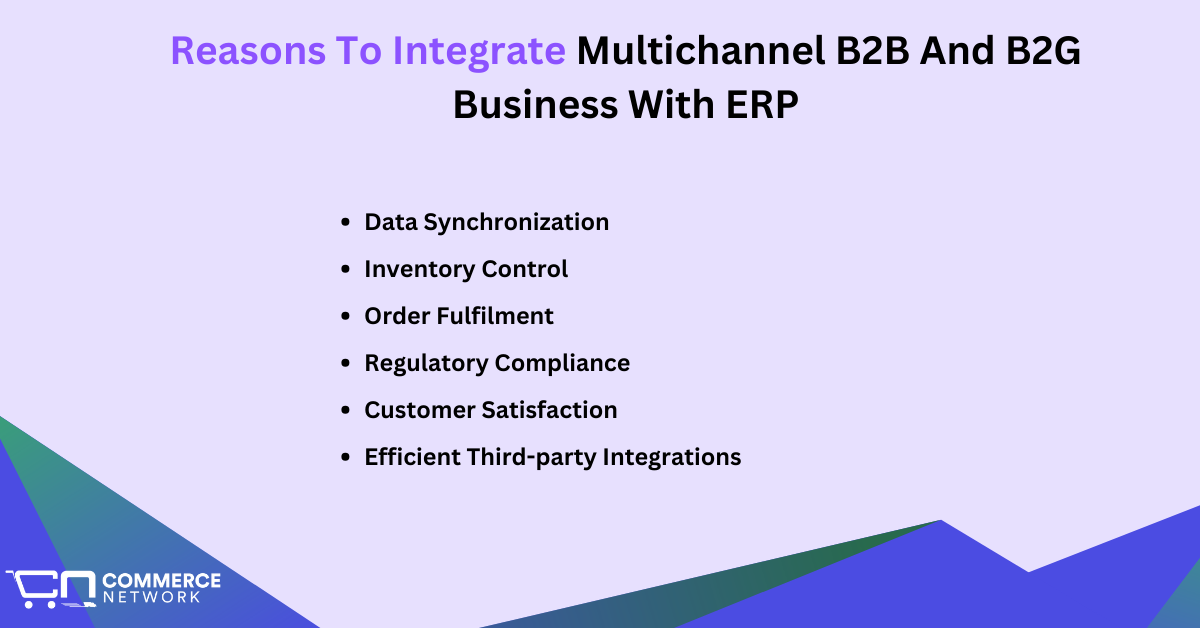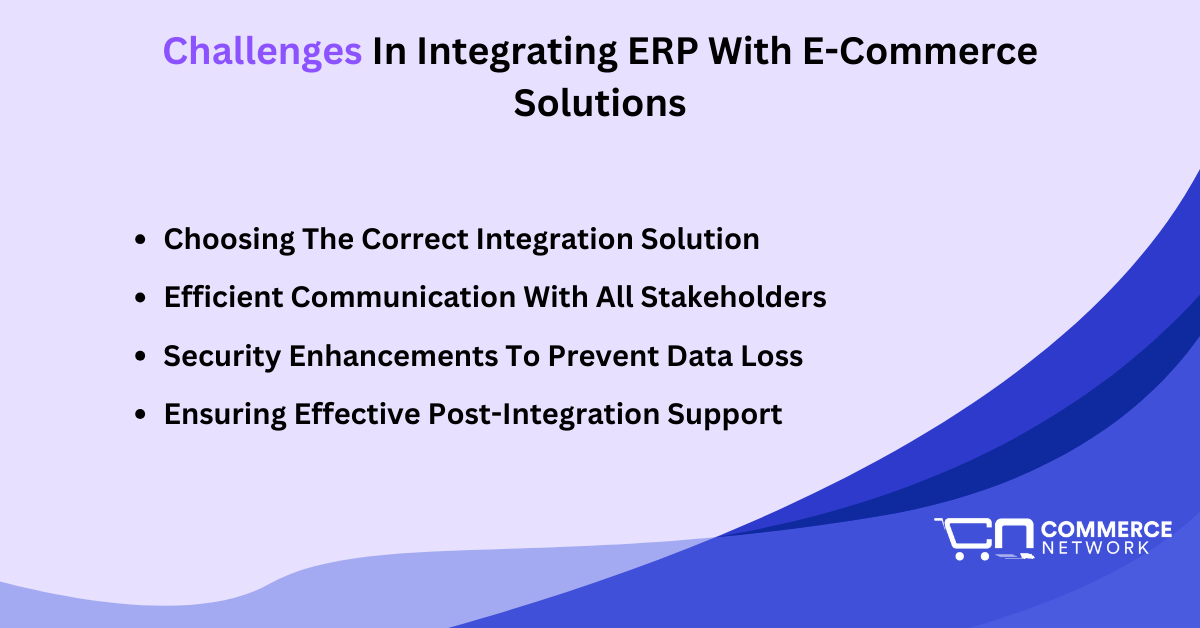By Bipin Dhungana | January 07, 2025

Enterprise Resource Planning (ERP) systems are critical for a business. They help manage all sorts of business processes from order fulfillment, inventory, customer relations, and more.
Integrating the ERP platform with e-commerce for B2B and B2G transactions significantly enhances the efficiency, connectivity, and profits of a business.
Multichannel businesses need an effective solution that can give an overview of the overall business operations across channels. An ERP solution is perfect for this purpose. However, it is not simple to integrate ERP with the B2B and B2G multichannel e-commerce businesses.
This article discusses what multichannel businesses are, their need to integrate ERP with their e-commerce ecosystem, and the steps, challenges, and solutions in detail.
Let us get started.
Multichannel or omnichannel platforms include multiple avenues where a business can sell its products.
An example can be a business selling its products from its online store, its physical store, as well as through Amazon.
B2B and B2G e-commerce involve multiple sales channels, including direct contractual sales, sales through commercial marketplaces like Amazon and Walmart, sales through their online storefronts, GSA Advantage sales, and sales on platforms like FedMall.
B2B platforms include sales through online stores, commercial marketplaces like Amazon, Shopify, and Walmart, and direct contact with other businesses.
Businesses can also enter into contracts with other businesses to sell certain products over a lengthy period of time.
B2G e-commerce platforms encompass government marketplaces like GSA Advantage and FedMall, procurement portals like GSA eBuy, selling directly to government agencies through contract and bidding, etc.
Consider a business that wants to sell to multiple B2B and B2G buyers. Its multichannel e-commerce solution consists of several unique features setting it apart from a single channel platform.
The platform will have the following features:
Omnichannel Integration: The e-commerce solution connects different sales channels like websites, mobile apps, marketplaces, and government procurement portals into a unified platform.
Custom Pricing and Catalogs: The solution can offer personalized pricing, bulk discounts, and tailored product catalogs for B2B and B2G customers.
Compliance and Regulations: The platform ensures that all transactions meet specific industry and government compliance standards.
Order Management and Tracking: Provides robust order management features, including advanced tracking for both businesses and government buyers.
Check out Commerce Network’s E-Commerce Suite If You Want Your Own MultiChannel B2B and B2G Platform

An Enterprise Resource Planning (ERP) system is a software solution that combines various business processes into one centralized system that helps manage the core operations of the business.
An ERP basically acts as the core business solution integrating many different components of a business process like inventory management, financials, supply chain, human resources, customer relations, and more.
A business operating on a B2B and B2G landscape will have multiple trading partners, usually dealing with large volume transactions, needs to manage compliance and regulations, optimize supply chain efficiency, manage order processing, streamline inventory, and more.
An ERP system acts as the centralized operation controls system enabling the business to operate smoothly.
Without a robust ERP, a B2B and B2G platform faces several difficulties in functioning. And in the modern landscape where competition is everywhere a business with functioning difficulties can and will face severe pressure to sustain, expand, profit, and increase its overall bottom line.
Here are some key reasons why multichannel B2B and B2G e-commerce business requires integration of ERP into their systems.
Synchronizing sales data, product data, and other related data across multiple platforms for B2B and B2G sales is quite challenging if done manually. An ERP system significantly reduces manual data entry, automates data exchanges, and increases efficiency.
Inventory control involves making sure that the inventory data across multiple platforms remain consistent, the warehouse and inventory data are accurate so as to avoid stockouts, etc.
This becomes simple with the use of an ERP system. Customer orders are sent to the ERP platform which then updates the inventory data making sure that accuracy is maintained.
Order processing and procure-to-pay cycles will be positively affected through the use of an ERP system making the order fulfillment process smooth.
With all departments involved in order fulfillment and delivery getting accurate data and instructions through ERPs, orders can be quickly processed, and finances can be streamlined.
Compliance with regulations matters in B2G sales as government procurement and sales always follow regulations and terms of the contracts.
Maintaining compliance is only possible with a reliable set of data. Reliable data is only available in an error-free environment.
This error-free environment can be generated through the use of an Enterprise Resource Planning (ERP) solution that removes errors caused by manual entries.
Integration with eCommerce allows for personalized experiences, such as custom catalogs or pricing for different customers.
This helps customers benefit by making their purchase and collaboration journey better in a B2B and B2G scenario.
ERP integration improves customer satisfaction and loyalty by providing faster order processing, real-time order tracking, and personalized service.
B2B and B2G e-commerce businesses need to constantly integrate, collaborate, and communicate with third-party vendors.
Some such scenarios include subcontractors joining with a prime contractor in fulfilling a government procurement contract, communicating with multiple distributors, retailers, suppliers, and wholesalers in a supply chain, and maintaining vendor-specific catalogs in their e-commerce solutions.
Integration with the ERP system helps businesses automate and synchronize data, enable productive workflows in the supply chain, ensure reliable communications, and maintain optimal inventory control.
All these functionalities eventually help the business smoothly integrate with other third-party partners in the e-commerce network.
While most B2B and B2G businesses with omnichannel sales platforms use ERP systems like NetSuite to streamline operations, they cannot effectively integrate their ERP system with the E-commerce platforms.
Here are some steps on how to integrate an e-commerce business in the B2B and B2G landscape with the ERP system.
Define and extrapolate what to achieve from the integration. Make sure all the employees and related stakeholders understand the end goal of the integration.
Is it to enhance efficiency? Just maintain compliance? Manage the order fulfillment? Or is there another specific reason to integrate ERP with the existing e-commerce system?
Being clear about the end goal of integration helps focus on the integration process and align your expectations with the reality of integration. It also prevents you from getting sidetracked during integration.
Which e-commerce business process are you going to integrate with ERP? Is it inventory management, order fulfillment, accounting, or other supply chain process?
You should further figure out how you are going to integrate e-commerce with the ERP systems and subsystems. For example, you could integrate the order fulfillment process of e-commerce with ERP first and then gradually integrate other processes like customer management and accounting.
Another important aspect to note is to figure out whether the ERP and the e-commerce systems are compatible for integration or not. Can the integrated system handle large volume transactions in peak periods? Will there be a conflict between a small function of the ERP while integrating with the storefront or other sales channels, eventually affecting the whole system?
These are questions that need to be answered and a clear definition of what to integrate, how to integrate, and the challenges and potential difficulties that the integration may face all need to be addressed in this step.
This is the actual step where the integration happens. You map out the data fields and segments between the e-commerce platform and ERP systems and make sure that the data is correctly being exchanged.
The process more often than not also includes creating custom functionalities for mapping, translation, and integrations for specific areas and processes on the ERP system so that those processes can run well with e-commerce transaction documents in all sorts of complex and dynamic environments.
This is one of the most important, harrowing, and time-consuming steps of integrating an e-commerce platform with any system, be it the ERP, Accounting, CRM, WMS, or other business systems.
Many businesses simply do not pay much attention to this process. Testing some functionalities and integration aspects and validating them to be safe does NOT mean that the integration process as a whole is smooth. It's just that the problem has not been found yet.
So, rigorous testing is extremely important. Those who rigorously test the integration find out numerous underlying problems from small program errors to large-scale integration failures.
All of these problems need to be solved before going to the eventual rollout of the integration.
Why?
Because inefficient testing leads to problems cropping up at any time. And most of the time, it will be during the sensitive transaction processes being operated on the multichannel system, seriously hampering the business process.
A multi-channel environment warrants high-level testing even more because there are many channels of sales. So testing and validation of one channel may not help with the integration of ERP and e-commerce for another channel.
Only run the integration on a live environment after solving most errors. This ensures that the eventual integration results will be accurate, error-free, and long-lasting during e-commerce transactions, thus helping improve customer satisfaction and brand credibility.
After testing the system, you eventually roll out the integrated ERP-E-commerce system into your live business environment.
The rollout process often involves company-wide announcements, staff training, and adoption, and enforcing guidelines and Standard Operating Procedures (SOPs) for the integrated system.
It also involves another critical factor; post-integration.
Post-integration support, maintenance, updates, and training are extremely important. The changing business dynamics, availability of new updates, security patches, troubleshooting issues, system running errors, etc. all warrant a robust and capable post-integration environment.

Problems ranging from small to big always appear during any integration of two systems. It is similar to the case when integrating the omnichannel e-commerce platform with an ERP system.
Here are some problems, challenges, and solutions that can help a business avoid pitfalls when trying to integrate ERP with e-commerce.
If you are one of those businesses, carefully consider the following problems, challenges, and solutions before trying to integrate your ERP with the online e-commerce business involving multiple channels.
Problem: Choosing the wrong integration solution
Numerous solutions help integrate an ERP solution with your online business. You will definitely get overwhelmed trying to choose one. And choosing the wrong one can have many problems.
An ERP and the e-commerce business change constantly, and can often be complex to map out, integrate, and troubleshoot. They also differ according to the unique needs of your business.
If you choose the wrong solution, the integration will be affected as the data field mapping, coding for additional functionalities for specific needs, and the overall integration process will be affected.
Challenge: Finding The Right Solution
The challenge, however, is finding the right solution for your business. Some solutions can be dazzling and you may think they are a perfect fit only to eventually find out that is not the case. Some solutions on the other hand can only work on specific e-commerce environments and may not support multichannel support.
Choosing the right connector to connect ERP with E-commerce involves a try-and-test method where you can try and test all available solutions that you think might be helpful for integration.
Solution: Commerce Network’s Netsuite ERP Connector
Commerce Network has a connector with custom functionality that can connect your multi-channel e-commerce platform with the NetSuite ERP system.
Contact us to give our system a trial.
Problem: Insufficient Coordination And Help From Trading Partners And Employees Affecting The Integration
If you cannot connect and communicate with all the involved parties in the integration, the process becomes riddled with difficulties. In the case of ERP-eCommerce integration, the involved stakeholders include pretty much the whole business including the employees, the trading partners, and even customers.
Challenge: Effectively Communicate With Partners And Stakeholders
Navigating the communication challenges can be difficult as ERP and E-commerce are both a big part of your business involving a wide range of aspects from customer relations, order fulfillment, sales, marketing, operations, and more.
In a multichannel B2B and B2G e-commerce scenario, you may also need to communicate with the participants of the channel. E.g, you may need to communicate with the GSA Contracting Officer about the integration of ERP with your B2G e-commerce platform on GSA Advantage.
So, communication with each department, external stakeholders, sales channel representatives, and even in between teams can be a challenge while integrating ERP with your e-commerce.
Solution: Open Channels Of Communication 24/7, Actively Engage In Communication
The best thing to do is to provide an open channel of communication so that each party involved in the business can communicate with each other and eventually, you, the business owner.
In an open communication environment, concerns can be voiced quickly, solutions can be effectively implemented, and concerns can be mitigated.
Problem: Security Issues Consisting Of Data Breaches, Mishandling, And Security Compromise
Security issues cannot be overlooked when implementing ERP and E-commerce integrations. As the ERP system of a business handles large amounts of sensitive data, In the case of data breaches or data loss during integration, the problems can compound over time and severely affect the business.
Challenge: Improving The Security Environment For The Integrated Solution
Implementing an effective solution for the integration can become a challenge as businesses need to implement additional costs, resources, and oversight on security. However, not enhancing security poses its own set of risks as mentioned earlier.
Solution: Implement Severe Security Measures, Enable Firewall Protections and authentication Protocols, And Impose Strict Security Guidelines
This is the perfect solution to counter the security challenges for ERP and e-commerce integration. In the case of businesses with multiple channels in a B2B and B2G environment, compliance management, and following the regulation becomes easy with the effective implementation of these solutions.
Problem: Insufficient Support And Post-Integration Issues
Even if the implementation of the integrated solution proceeds without a hitch, problems are bound to crop up at any time afterward. This makes post-integration an important issue, Many businesses end up not having a solution that effectively manages the post-integration efforts causing errors in their workflows in their overall supply chain efficiency.
Challenge: Finding The Right Partner That Offers Post-Integration Support
Again, the challenge comes in the form of finding the right solution partner that offers robust post-integration support. You should look for a credible partner with a good reputation that has a track record of satisfying its clients during the post-integration phase.
Solution: Commerce Network’s 24/7 Support For Operations, Maintenance, Troubleshooting, Error-handling, and Customer Service
One effective solution can be Commerce Network’s SaaS system equipped with the NetSuite ERP connector that provides good post-implementation operations and training.
Our vast range of hundreds of clients and customer feedback can give you the answer to your post-integration woes as we take customer support in high regard.
Integrating ERP systems with multi-channel B2B and B2G e-commerce platforms empowers businesses to operate seamlessly, reduce manual processes, and meet the demands of modern commerce.
With the right integration strategy, companies can boost operational efficiency, improve decision-making, and deliver consistent value to their customers and government partners. Embracing this synergy ensures a future-ready approach to thriving in an ever-evolving marketplace.
Improve Your B2B, B2G, and B2C Ecommerce?
Integrate EDI For Efficiency, Compliance, and Scalability?
Just Curious About EDI?
Give Us A Call
202-280-7060